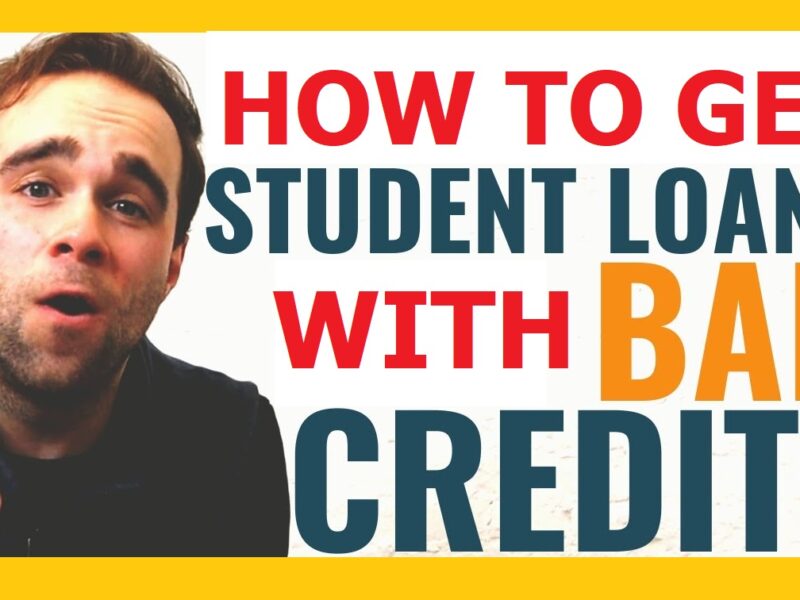If you have bad credit, getting a student loan might seem impossible—but the good news is that it’s not. Whether you’re a returning student, a recent high school graduate, or an adult pursuing higher education, there are accessible loan options even with poor credit history.
In this comprehensive 2025 guide, we’ll walk you through:
- Understanding credit scores and their impact
- The difference between federal and private loans
- Strategies to qualify for loans despite bad credit
- Cosigner and no-credit-check loan options
- How to boost approval chances
- Top lenders and resources
What Is Considered Bad Credit?
Credit scores range from 300 to 850. Here’s the breakdown:
| Credit Score Range | Rating |
| 800–850 | Excellent |
| 740–799 | Very Good |
| 670–739 | Good |
| 580–669 | Fair |
| 300–579 | Poor (Bad Credit) |
If your credit falls below 580, traditional lenders may view you as a high-risk borrower. But that doesn’t mean you can’t fund your education—especially if you know where to look.
Federal Student Loans: Best Option for Bad Credit Borrowers
The best student loan option for those with bad credit is federal student loans because:
- They don’t require a credit check (except for PLUS loans)
- Offer fixed, low interest rates
- Come with income-driven repayment plans
- Offer loan forgiveness programs
Types of Federal Student Loans:
| Loan Type | Credit Check Required? | Max Amount (Undergrad) | Interest Rate (2025 est.) |
| Direct Subsidized Loans | ❌ No | $3,500–$5,500/year | ~5.5% |
| Direct Unsubsidized Loans | ❌ No | $5,500–$7,500/year | ~5.5% |
| PLUS Loans (Parent/Grad) | ✅ Yes (Lenient) | Cost of attendance minus aid | ~8.05% |
Apply via FAFSA at studentaid.gov. It’s your first step to securing federal financial aid.
What If I Need More Than Federal Loans Offer?
Federal loans may not cover the full cost of tuition, housing, books, and living expenses. That’s where private student loans come in—but these often require good credit.
If you have bad credit, here are your options:
1. Use a Creditworthy Cosigner
Most private lenders will approve your loan if you bring a cosigner with strong credit. This person—often a parent, spouse, or trusted friend—shares responsibility for repayment.
Pro Tip: Some lenders offer cosigner release after 12–24 months of on-time payments.
2. Bad Credit-Friendly Lenders
Some lenders specialize in alternative underwriting, which means they look at income, education potential, and employment—not just credit scores.
Examples of lenders that may approve bad credit loans:
| Lender | Minimum Credit Score | Cosigner Option | APR Range (2025 est.) |
| Ascent | 600 (or none w/ cosigner) | ✅ Yes | 4.43% – 13.16% |
| Earnest | No strict min. | ✅ Yes | 4.99% – 11.74% |
| Funding U | No cosigner needed | ❌ No | 6.99% – 12.99% |
| MPOWER | International & DACA-friendly | ❌ No | 7.52% – 13.63% |
| A.M. Money | No credit check | ✅ Optional | 7.05% – 13.58% |
Be cautious of loans with variable interest rates or origination fees.
Boosting Your Chances of Approval
Even with bad credit, you can take proactive steps to improve your loan eligibility.
1. Build or Repair Credit
- Pay existing bills on time
- Reduce credit card balances
- Monitor your credit report at AnnualCreditReport.com
- Dispute errors that hurt your score
2. Get a Part-Time Job or Side Income
Some lenders will consider your income-to-debt ratio instead of credit score alone.
3. Enroll in a Community College First
Starting at a low-cost institution reduces borrowing needs, which can make approval more likely.
4. Apply for Scholarships & Grants
Unlike loans, these don’t require repayment or credit checks.
Scholarships and Grants That Don’t Consider Credit
- Federal Pell Grant – Up to $7,395/year
- FSEOG (Supplemental Grant) – $100–$4,000/year
- State-based grants – Vary by location
- Institutional scholarships – Based on merit, not credit
- Private nonprofit scholarships – e.g., Hispanic Scholarship Fund, UNCF, etc.
Use websites like FastWeb or Scholarships.com to find awards.
Student Loan Alternatives for Bad Credit Borrowers
| Option | Description |
| Income Share Agreements (ISAs) | Pay a % of income after graduation instead of upfront loan |
| Employer Tuition Assistance | Some jobs offer $5,250/year in tax-free education aid |
| Military Education Benefits | GI Bill, Tuition Assistance, and ROTC cover college costs |
| Work-Study Programs | Earn money through on-campus or virtual part-time jobs |
| Community College + Transfer | Pay less up front, then transfer to a 4-year university |
FAQ – Student Loans with Bad Credit
Q1: Can I get a student loan with a 500 credit score?
Yes. You can qualify for federal loans and some private loans with a cosigner or alternative underwriting.
Q2: Will my credit affect my FAFSA application?
No. FAFSA does not consider your credit score—only your financial need.
Q3: Is it better to apply with a cosigner?
Absolutely. A cosigner with good credit increases approval chances and helps you access lower interest rates.
Q4: Can international students with bad credit get loans?
Yes. Some lenders like MPOWER and Prodigy Finance offer loans without U.S. credit history.
Q5: What’s the fastest way to improve credit?
Pay bills on time, reduce credit utilization, and dispute negative errors on your credit report.
You Can Still Fund Your Future
Having bad credit doesn’t mean you’re out of options. With the right mix of federal aid, bad credit-friendly lenders, and scholarships, you can still afford a degree and change your future.
Start by submitting your FAFSA, research lenders that accept your situation, and take proactive steps toward financial aid—even if your credit isn’t perfect.










